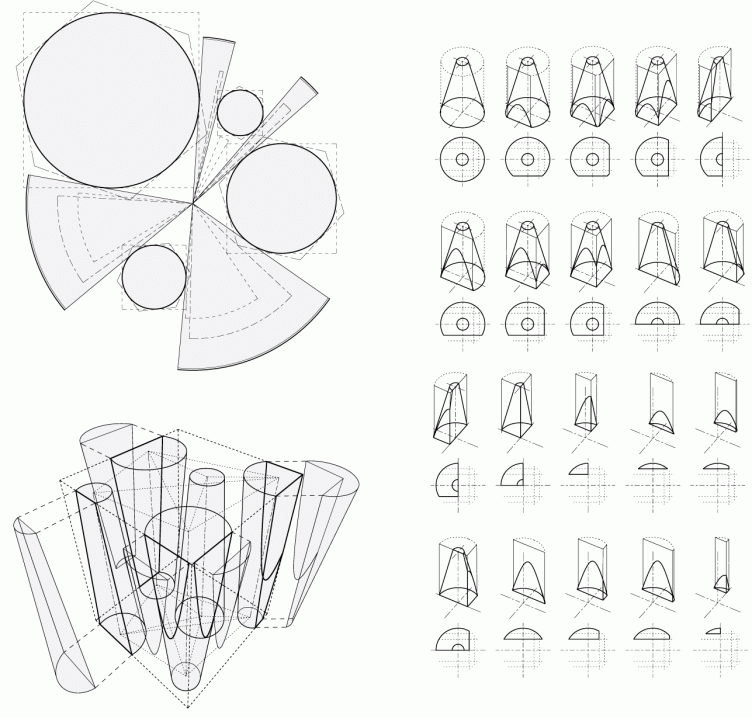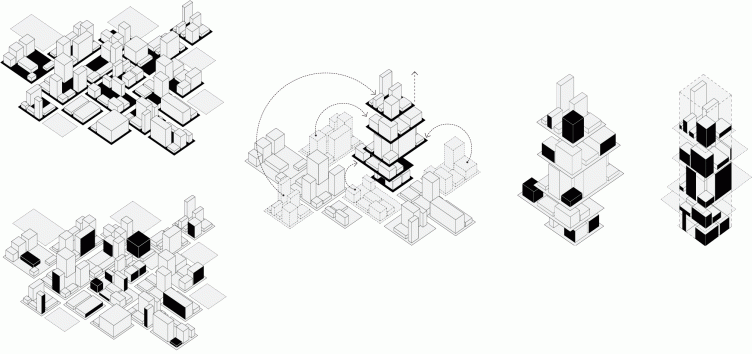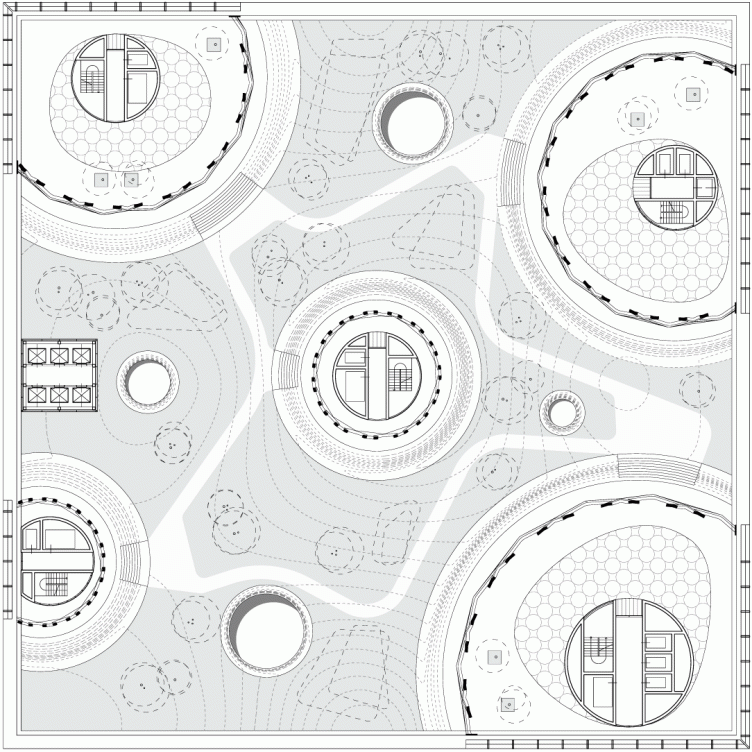Moscow" fair.
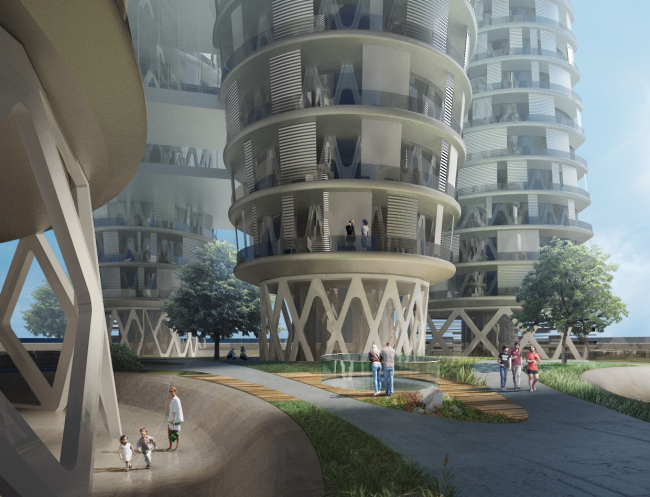
Project of the skyscraper upon the Arcology concept for Hong-Kong. 2014 © TOTEMENT / PAPER
According to the terms and conditions of the contest that took place this spring, the participants were to propose a design of a high-rise building that will be built in one of the most high-profile places of Hong-Kong, on the shore next to the Expo Center. The skyscraper was not to be just excellent but "arcological" - meaning, answering the Arcology concept - which was proposed by the architect Paolo Soleri back in 1969, he started to implement it at that time but never finished it - this concept is still to be found more in sci-fi books and movies than in the architecture, which is admitted in their brief, repeating the Wikipedia, by the authors of the contest concept. According to this semi-sci-fi concept (the word is actually a combination of "architecture" and "ecology"), the building must be completely self-sufficient and fully capable of serving itself, being "passive", causing no harm to nature, and including everything necessary for normal life. The main thing (that actually makes the concept particularly "sci-fi") about this building is that besides the traditional for any contemporary mixed-use complex residential premises, offices, and public spaces, the building must also has in it agricultural farms providing the entire place with food. According to the Soleri concept, the "arcological" building does not necessarily have to be a skyscraper, but Hong-Kong is a high-rise city, and required particularly a super-skyscraper, i.e. a building no less than 300 meters tall.
As an answer to this challenge, the architects of TOTEMENT/PAPER (with considerable input from the bureau's young architect Egor Legkov - stress the bureau's leaders Levon Airapetov and Valeria Preobrazhenskaya) proposed a skyscraper totally unlike the "usual" high-rises of the modern world. They remembered and developed an idea of their own, one that they had already tried with the project of an expo and business center in Sakhalin - it consists in the fact that the architectural matter is formed in accordance with a specific plastic "code". In this case, just like at Sakhalin, the space and the plastics are formed by the multiply repeated cones of different sizes, some of which are turned upside down, i.e. they are narrowing downwards. Thus, the plan of the building consists of numerous circles, the vertical outlines are slanted, and the dissection of any constituent part by a vertical surface turns out parabolic. By using this technique, the architects get a rather broad range of unconventional shapes, setting, as the basis of their plastic code, but a single and clearly readable unit of a cone.

"Stereotonomy" layout © TOTEMENT / PAPER
However, a more important technique in this project (just as in the Sakhalin one) is not the cone as such but its section. The authors gave their main technique a name of "stereotonomy" that they literally decipher as "dissection of a volume": the city matter that consists of conical buildings and spaces between them is dissected by planes at the borders of the land site - like Swiss cheese or a piece if water-melon cut out from the whole. Such an approach - and the architects specifically stress this - allows for an indefinite development broadways: let us imagine a city the blocks of which consist of cone-shaped buildings, rather closely placed on green lawns - a forest of sorts of "tree-trunk" houses, dissected by the streets, and where the red line of the site runs over the mass of the cone, they grow into one another, forming a surface with parabolic outlines. This approach is opposed to the classical "square block" one where the houses are built along the perimeter of the land site, and, at the same time, the freedom of section allows to inscribe such "urban matter" into any street grid.
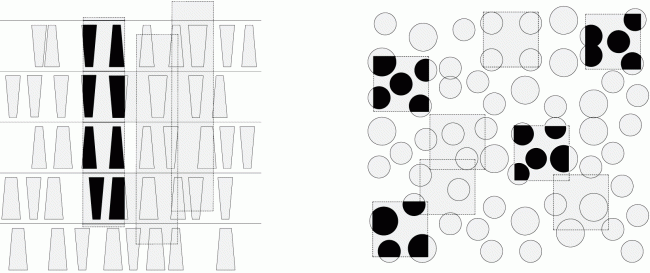
"Stereotonomy" layout © TOTEMENT / PAPER
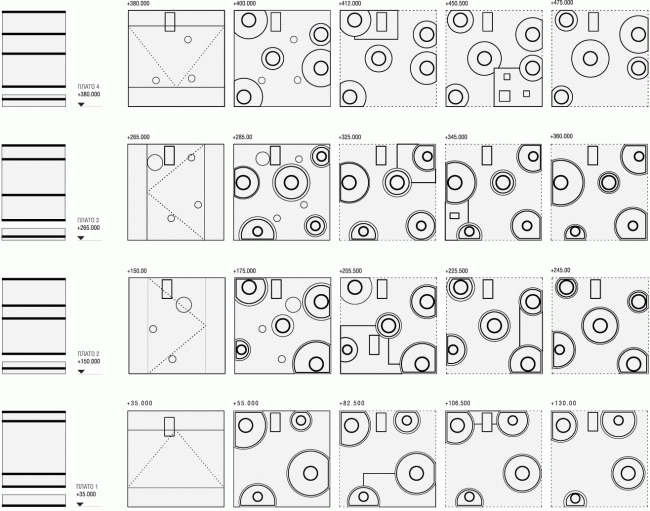
Section views of the floors © TOTEMENT / PAPER

The sucession of forming the "vertical block" in the project © TOTEMENT / PAPER
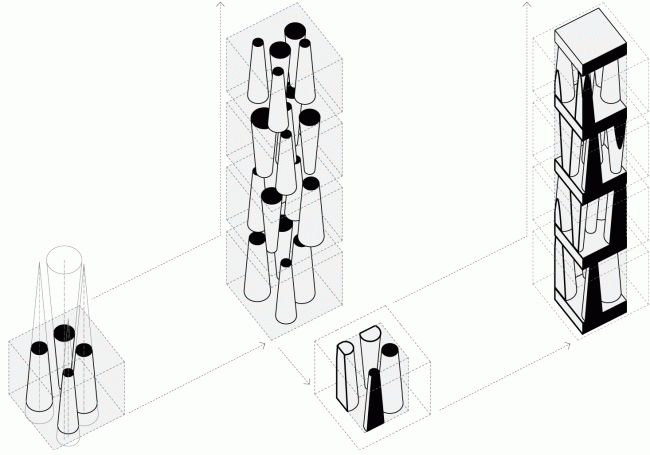
"Stereotonomy" layout © TOTEMENT / PAPER
Still more important here is the vertical development of this idea. At this point, the "tectonics" comes into play: the 17-story cone houses plus the tall upper and lower tiers (their facades are designed in the form of diagonal girders, the idea being both feasible and expressive). Each group of the houses rests on a single-piece stylobate that has three agricultural tiers in it (there are fish farms, kitchen gardens, and even dairy farms), each tire supporting another one of the same kind. This pattern is repeated four times: the "column" houses placed in a dense hypostyle five ones per tier carry the next stylobate with similar cone-shaped buildings. The buildings of the lower block are occupied by offices, the two middle ones - by apartments, and the top one, two hundred meter high, includes the hotels. Such "city" designed by TOTEMENT architects, is capable of duplicating itself not only broadways but upward as well. The authors call their concept a "vertical quarter"; it looks as if somebody cut out from the city pieces of the "soil", including the agricultural basis below and all the houses that grew out of it - all these things are put in a stack, entwined into a 3D grid, strengthened by common vertical communications (that also serve as the stiffeners).
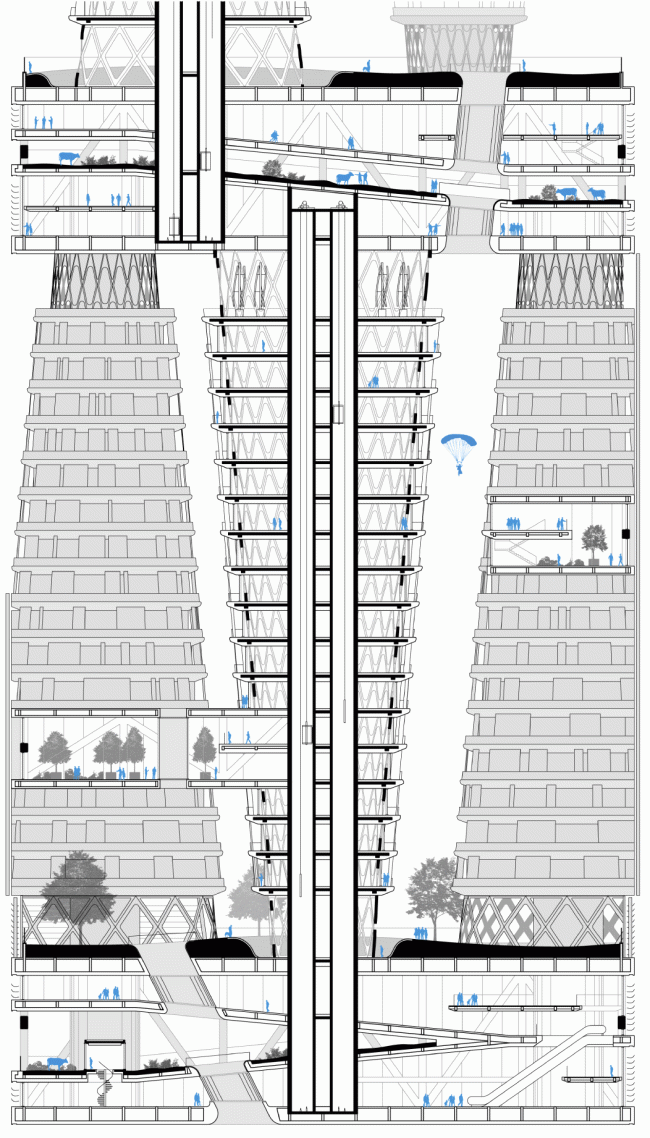
Section view © TOTEMENT / PAPER

Axonometric perspective © TOTEMENT / PAPER
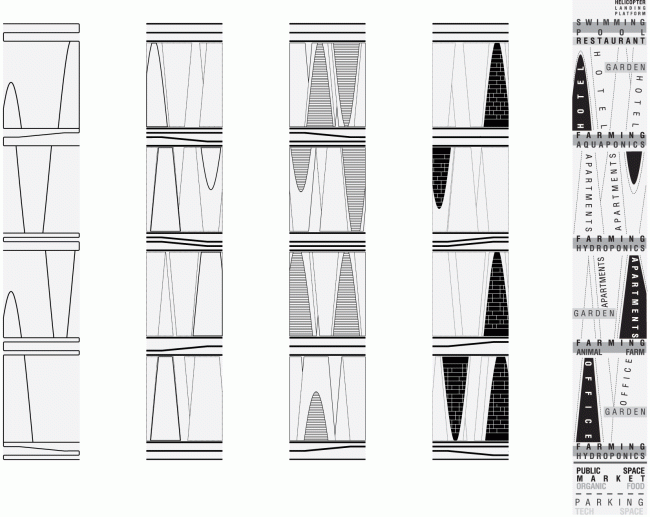
Silhouette of the building © TOTEMENT / PAPER
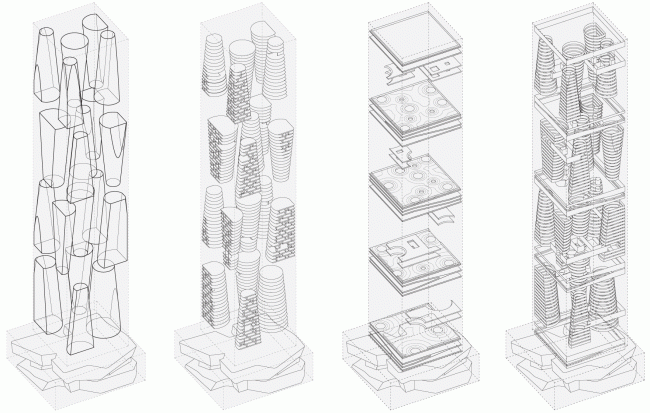
Structure: levels, platos, glazing © TOTEMENT / PAPER
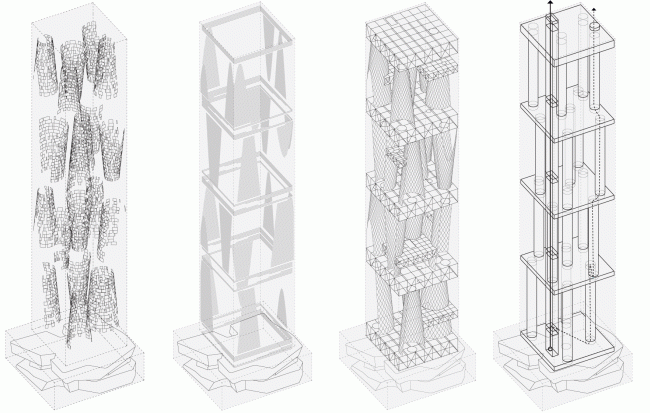
Structure: screens, lamellae, building structural system, vertical communication © TOTEMENT / PAPER
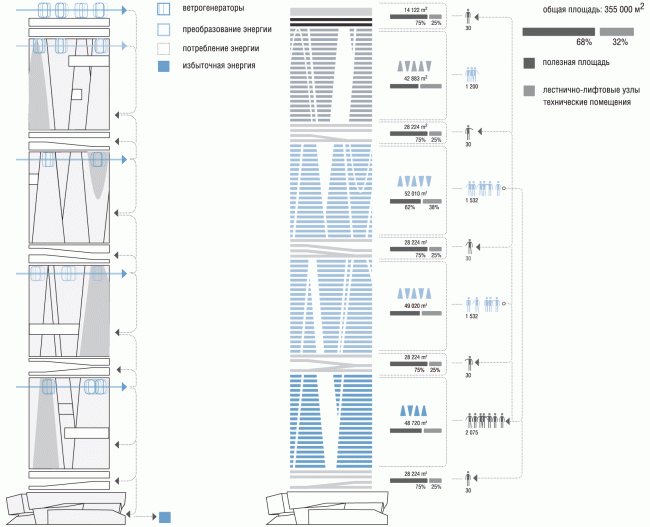
Wind energy. Balance of the areas.© TOTEMENT / PAPER
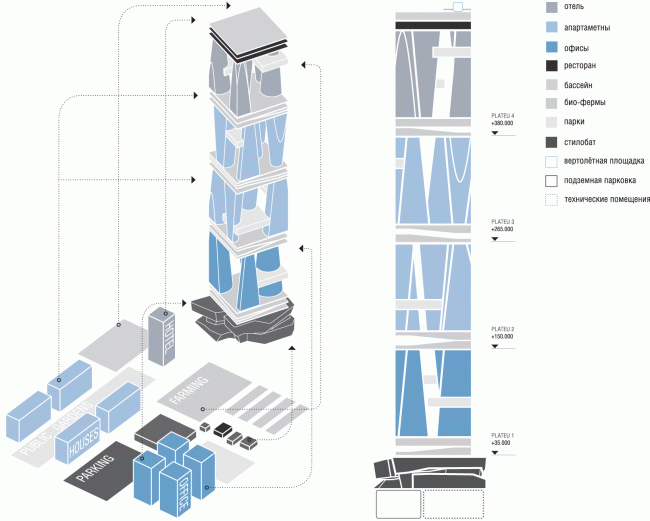
Program © TOTEMENT / PAPER
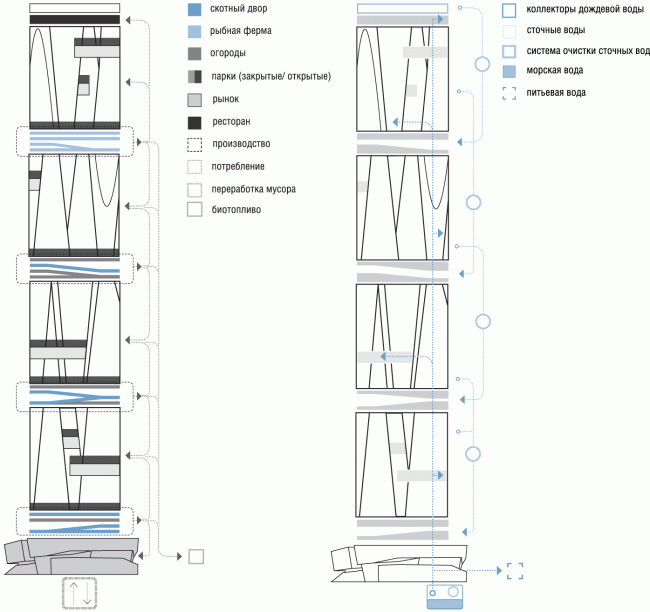
Food and biofuel. Sewage disposal © TOTEMENT / PAPER
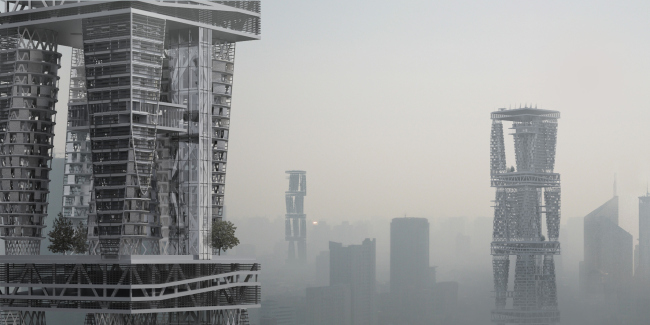
Project of the skyscraper upon the Arcology concept for Hong-Kong. 2014 © TOTEMENT / PAPER
"As a rule, the structure of today's skyscrapers is concealed behind the beautiful casing and that is usually sleek and at the same time pretty faceless - explains Levon Airapetov - what's inside is totally unclear, and those who look at such a tower from outside and admire its plastics, are not even supposed to know that. Our solution of the skyscraper is crucially different: this is a vertical city, it is open and not hidden with its structure plainly visible".
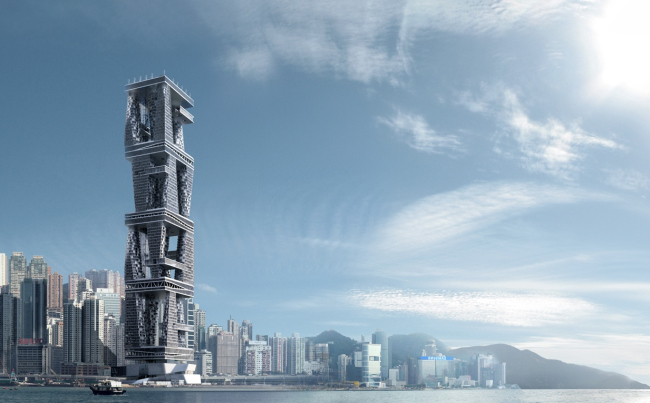
Project of the skyscraper upon the Arcology concept for Hong-Kong. 2014 © TOTEMENT / PAPER
The building's structure is indeed transparent, even windswept; the super-skyscraper gets a new "intermediate" scale: on the one side, it is still a giant, but, on the other side, this "inevitable" gigantism gets fractured, divided into fragments that are accessible to human perception (at any rate, twenty stories are less than a hundred).
Of course, one cannot claim that the idea of a vertical city is 100% groundbreaking: it was proposed rather a long time ago, just like Soleri's "arcology". The idea of connecting the towers with bridges (well, one will have to move around, say, between the 70th floors), cutting the large volume with openings, or likening a high-rise to a stack of houses climbing upward on one another's shoulders is not new (see De Rotterdam by Rem Koolhaas or M-City by Vladimir Plotkin).
At the same time, the TOTEMENT project takes the very principle of a vertical city to a point of ultimate clarity. It looks like a fragment of the ultimate, ready for duplication, city of the future and presents a sketch of a system, in its essence akin to the "quarter" system of some historical city. This, however, is not a version of such a quarter but rather an alternative to it springing out of new conditions. The classic quarter, strictly speaking, also performs the function of the city's "gene code", only not developed by humans but historically formed, the quarter grid being part of the grammar of the language that the city speaks. The TOTEMENT skyscraper offers a different set of rules, to a certain extent hybrid: from the city block the architects borrow the scale of the inner geometry, from the "garden city" - the houses placed on the green park lawn, from the quarter - the subjugation to the plot's boundaries that play the role of "dissecting planes", and, finally, from the skyscraper - the overall tallness, while the city lends the modesty of the tallness of each tier. From the classic architecture - a rather remote likeness of the round buildings with columns.
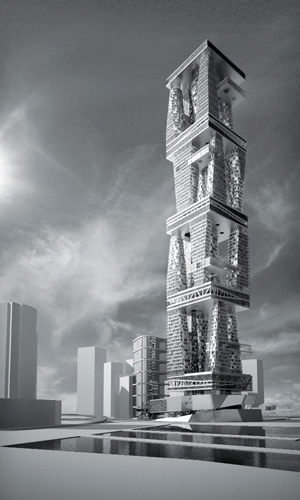
Project of the skyscraper upon the Arcology concept for Hong-Kong. 2014 © TOTEMENT / PAPER
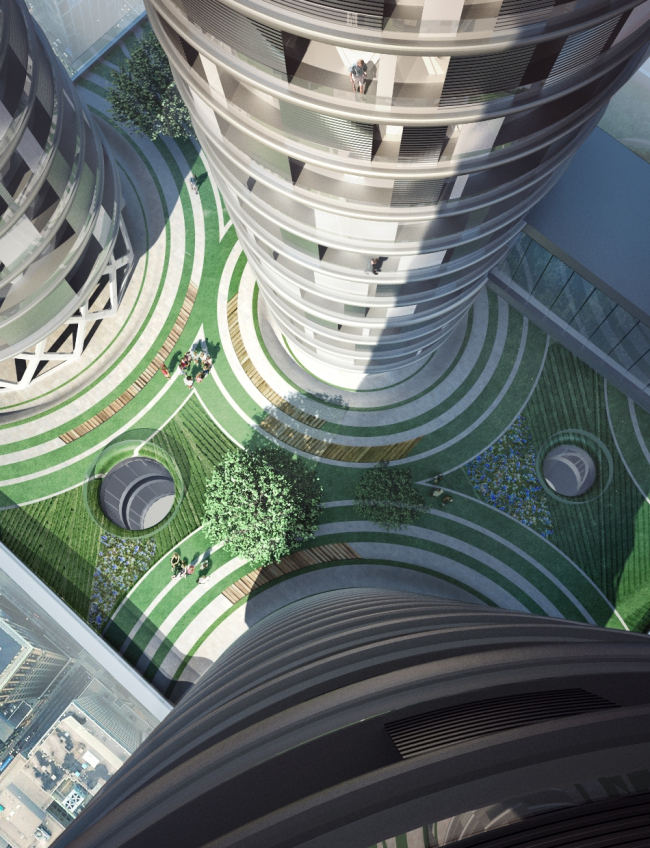
Project of the skyscraper upon the Arcology concept for Hong-Kong. 2014 © TOTEMENT / PAPER
The project has a lot of idealism about it, and this is why one would rather treat it as a study, an abstract statement on the subject of the language of architecture - more than a real-life project for any specific place (even though it would really fit in for Hong-Kong and it was really designed for a real-life contest, a contest of ideas, though). There's also something creepy about this gigantism also, especially if one is to think about the prospects of its possible implementation. "The younger members of the bureau were vocal critics of this project, they would even say that it's amoral even to set down to designing such scary giants - confess Levon Airapetov and Valeria Preobrazhenskaya – but to us it was an exciting opportunity to work with the shape".
Meanwhile, if we are to treat this project as a plastic statement, beyond the context of the future overpopulation of the Earth and the present of the Asian cities (and also the crammed-in areas just outside the Moscow Ring Road) - then the vertical city looks like a brave new attempt at reconciling the magnitude of a super-city and its towers with the humans, setting off the ambitious energy of its verticals with the down-to-earth horizontals of the farming "slabs". The tower in this case is devoid of aspirations to become "a monument to itself", rather, the architects disclose its "anthill" nature. Well, this is quite a sci-fi but nevertheless quite the "arcological" approach; its plastics accurately catch the shift of the accents in the high-rise construction. Because there are basically two meanings about the high-rises: aspirations (the happiness of reaching the highest point that no one else could reach) and the sheer necessity (overpopulation, anthill, and a forest of giant towers obscuring the sunlight). In this case, we see a dialogue of the former and the latter - which is an interesting thing in its own right.
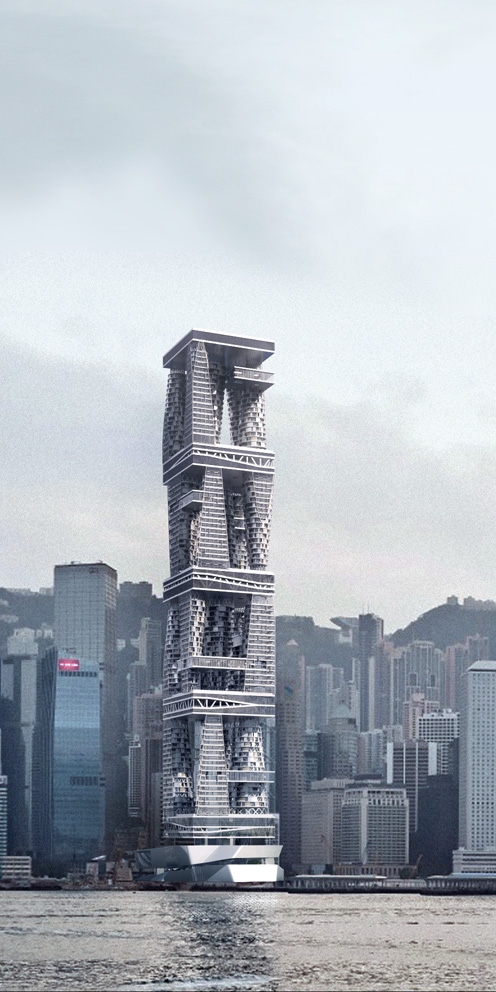
Project of the skyscraper upon the Arcology concept for Hong-Kong. 2014 © TOTEMENT / PAPER
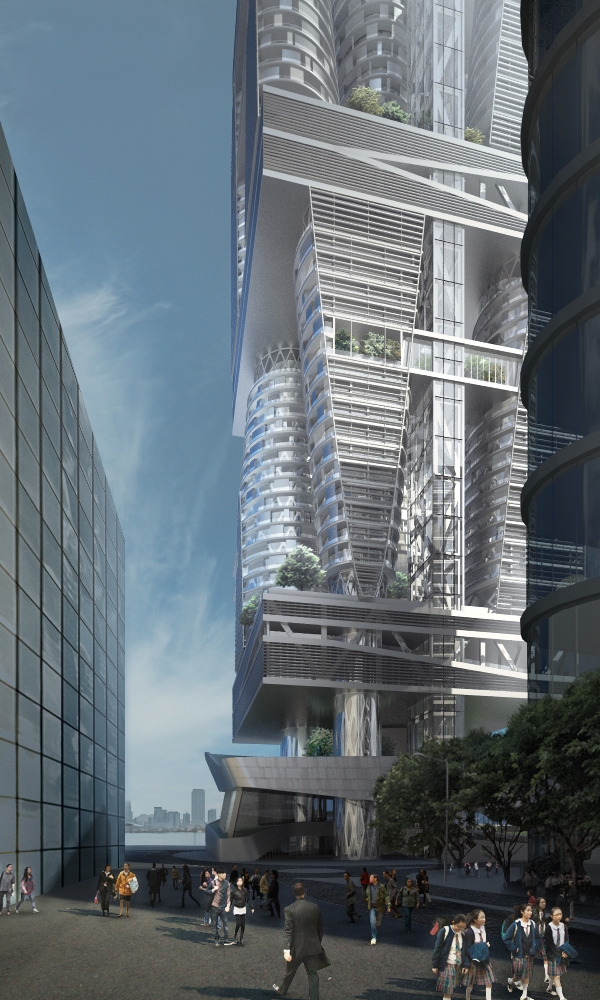
Project of the skyscraper upon the Arcology concept for Hong-Kong. 2014 © TOTEMENT / PAPER
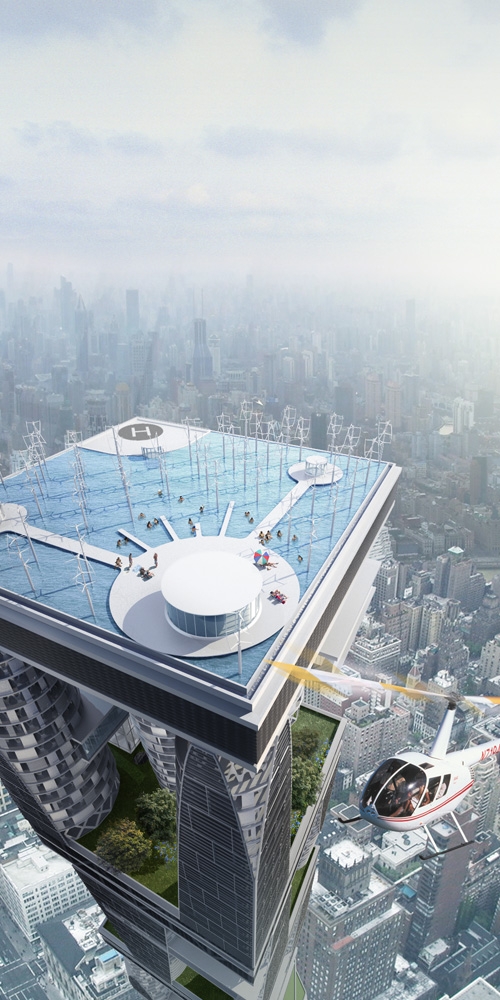
Project of the skyscraper upon the Arcology concept for Hong-Kong. 2014 © TOTEMENT / PAPER
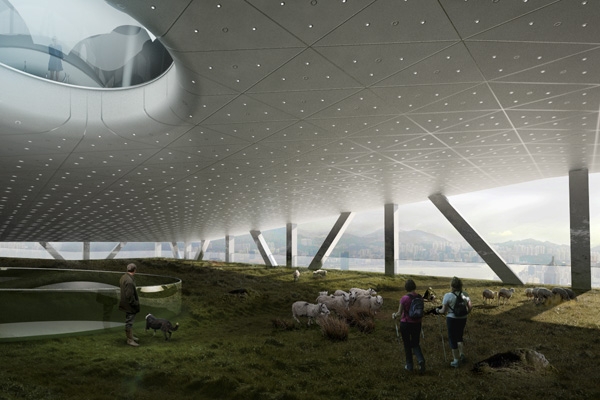
Project of the skyscraper upon the Arcology concept for Hong-Kong. 2014 © TOTEMENT / PAPER
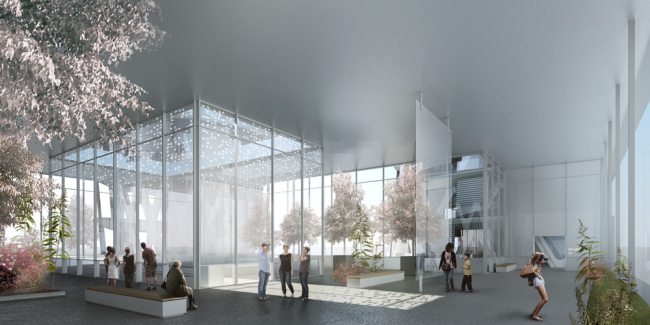
Project of the skyscraper upon the Arcology concept for Hong-Kong. 2014 © TOTEMENT / PAPER
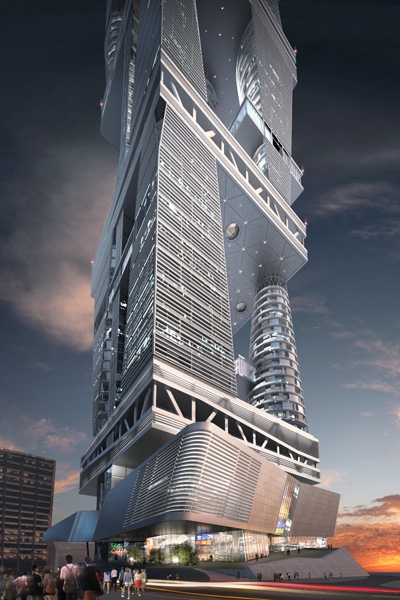
Project of the skyscraper upon the Arcology concept for Hong-Kong. 2014 © TOTEMENT / PAPER
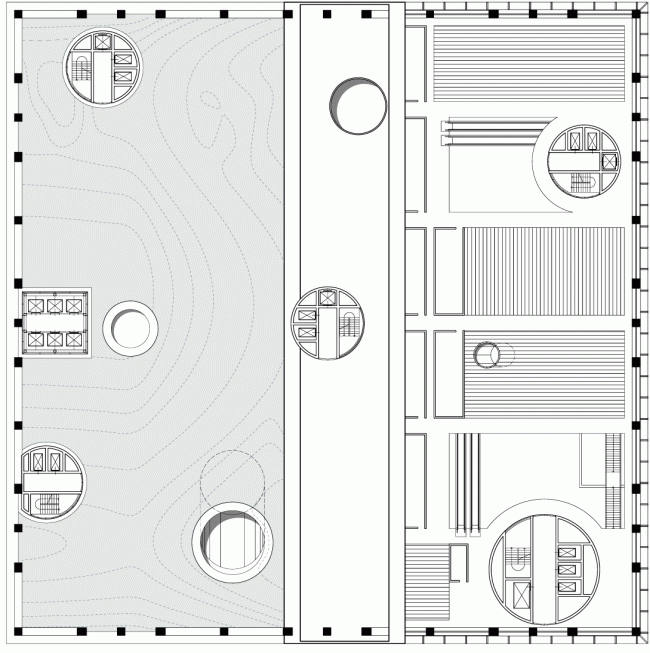
Plan: the level of bio farms © TOTEMENT / PAPER
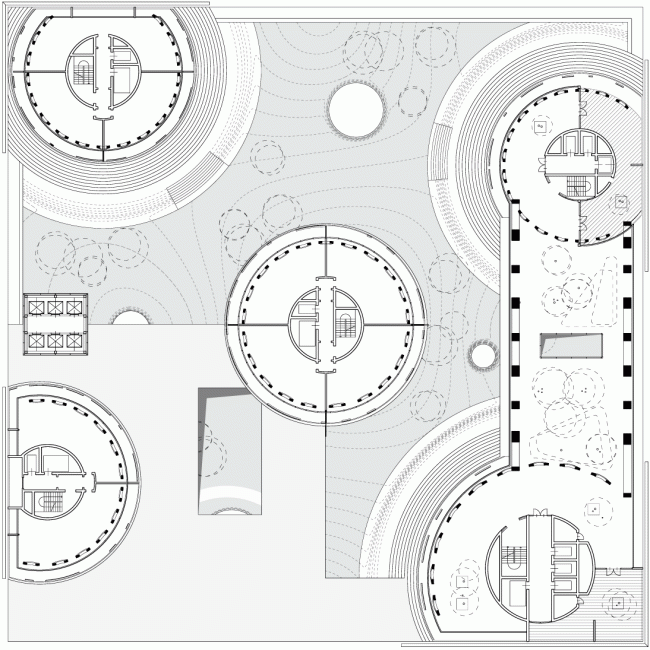
Plan: apartments and park © TOTEMENT / PAPER

Plan: courtyard © TOTEMENT / PAPER
Project of the skyscraper upon the Arcology concept for Hong-Kong. 2014 © TOTEMENT / PAPER
"Stereotonomy" layout © TOTEMENT / PAPER
"Stereotonomy" layout © TOTEMENT / PAPER
Section views of the floors © TOTEMENT / PAPER
The sucession of forming the "vertical block" in the project © TOTEMENT / PAPER
"Stereotonomy" layout © TOTEMENT / PAPER
Section view © TOTEMENT / PAPER
Axonometric perspective © TOTEMENT / PAPER
Silhouette of the building © TOTEMENT / PAPER
Structure: levels, platos, glazing © TOTEMENT / PAPER
Structure: screens, lamellae, building structural system, vertical communication © TOTEMENT / PAPER
Wind energy. Balance of the areas.© TOTEMENT / PAPER
Program © TOTEMENT / PAPER
Food and biofuel. Sewage disposal © TOTEMENT / PAPER
Project of the skyscraper upon the Arcology concept for Hong-Kong. 2014 © TOTEMENT / PAPER
Project of the skyscraper upon the Arcology concept for Hong-Kong. 2014 © TOTEMENT / PAPER
Project of the skyscraper upon the Arcology concept for Hong-Kong. 2014 © TOTEMENT / PAPER
Project of the skyscraper upon the Arcology concept for Hong-Kong. 2014 © TOTEMENT / PAPER
Project of the skyscraper upon the Arcology concept for Hong-Kong. 2014 © TOTEMENT / PAPER
Project of the skyscraper upon the Arcology concept for Hong-Kong. 2014 © TOTEMENT / PAPER
Project of the skyscraper upon the Arcology concept for Hong-Kong. 2014 © TOTEMENT / PAPER
Project of the skyscraper upon the Arcology concept for Hong-Kong. 2014 © TOTEMENT / PAPER
Project of the skyscraper upon the Arcology concept for Hong-Kong. 2014 © TOTEMENT / PAPER
Project of the skyscraper upon the Arcology concept for Hong-Kong. 2014 © TOTEMENT / PAPER
Plan: the level of bio farms © TOTEMENT / PAPER
Plan: apartments and park © TOTEMENT / PAPER
Plan: courtyard © TOTEMENT / PAPER






